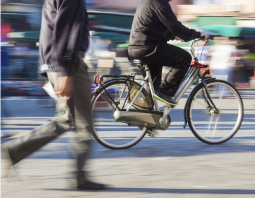Ease on down the road, but you still better think FAST! 
Between looming deadlines that demand action and simply wanting to be viewed as "doing something,” Capitol Hill often fills with a flurry of activity during the holiday season. While there has been activity on other legislative priorities, this message is exclusively about transportation.
AND, the news is very good.
Late last week Congress overwhelmingly approved a five-year reauthorization of the Surface Transportation Act (MAP-21) which the President signed into law on December 4. The new law is known as the Fixing America's Surface Transportation (FAST) Act.
Not only is it a five-year law, it also locks in funding for important active transportation programs. NRPA worked alongside our bike/ped partners and allies to see that funding for active transportation programs was protected. So, congratulations and thank you for this tremendous advocacy victory!
What follows is a summary of bicycle and pedestrian provisions in the new law and is an amalgamation of data collected by NRPA and partners, including Safe Routes to Schools National Partnership, the Recreational Trails Coalition, and Transportation 4 America.
Specifically:
- The Transportation Alternatives Program (TAP) is moved into the Surface Transportation Program (STP) and is now called the “STP setaside.”
- All core elements of TAP remain intact, including the same types of eligible projects and a competitive funding process.
 Overall funding for the program will increase from the current level of $819 million and grow gradually to $850 million beginning in 2018. We view this as progress which should make it easier to advocate for increases in a future reauthorization — the next now scheduled for 2020.
Overall funding for the program will increase from the current level of $819 million and grow gradually to $850 million beginning in 2018. We view this as progress which should make it easier to advocate for increases in a future reauthorization — the next now scheduled for 2020.- Nonprofits are once again eligible to compete for TAP funding.
- States will still have 50 percent of their TAP funding to use across the state or to transfer out to other road uses. The other 50 percent is divided up for projects in rural/mid-sized communities and among large metropolitan planning organizations (MPOs). This is current law, and is what the House proposed. The Senate had proposed to remove the state portion and put all the funding under local control.
- A subtle but important change: large MPOs that run their own competitions can now use up to 50 percent of their TAP money for any type of road project. However, these projects would still need to be submitted by local entities and considered under a competitive process. Given the generally small amount of money involved, it’s unlikely that many MPOs will use this provision. However, local agencies and groups should continue to advocate to MPOs to fully use TAP funds on TAP-eligible projects.
- FAST includes language meant to ensure productive and timely expenditure of funds which will (hopefully) make the implementation of projects and regulatory burden easier for these small projects.
- The Recreational Trails Program (RTP) is essentially unchanged from MAP-21. Annual funding remains at the same $85 million level over the five years and will be distributed among the states according to the same formula that has been in place since 2009. Unfortunately, the provision allowing the governor to opt out of the RTP also remains in place. While Connecticut was the only state who chose to opt-out this year, this will continue to be an annual concern. State and local trail advocates need to remain vigilant in convincing their governors to maintain the program as is each year.
Outside of TAP, there is additional good news:
- There is what many in the bike/ped community are calling, "Complete Streets Lite" language in which the Secretary of Transportation shall “encourage” states to adopt standards for the safe and adequate accommodation of all users, motorized and non-motorized, in all phases of planning, development and operation of transportation facilities.

- A new safety program, under the authority of the National Highway Transportation Safety Administration, was added that will provide about $14 million a year for bicycle and pedestrian safety in states that have a 15 percent or higher share of bike/ped fatalities. It funds awareness, education and enforcement.
- Design guidelines will now specifically include the NACTO Urban Street Design manual, which includes more progress designs to accommodate bicycle and pedestrian users and facilities.
- The threshold project cost for TIFIA loan eligibility is now down to $10 million. Hopefully this makes it easier for communities to use TIFIA to help pay for active transportation, pedestrian and bicyclist safety projects. This does, however, come at a very disappointing cost — for unclear reasons the bipartisan supported program is facing a 70 percent cut in annual funding (from $1 billion down to $275 million annually).
While we would have preferred the much stronger approach taken by the Senate, a status quo outcome for active transportation during these extremely difficult budgetary times must be considered a solid victory.
The bill ended up receiving overwhelming bipartisan support in both chambers. Final House passage was 359-65. The Senate vote was 83-16.
With that, THANK YOU again for your advocacy efforts on behalf of making our communities safer and more accessible for all and congratulations on this legislative victory! For the first time in about a decade, we can end one year and begin another knowing we have long-term, dependable funding for bicycle and pedestrian projects to look forward to.
Expect additional updates covering important priorities including the LWCF, environmental education, and the "omnibus" federal spending package in the coming days.
Dave Tyahla is NRPA's Senior Government Affairs Manager.

